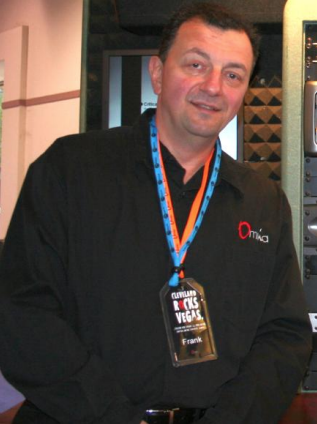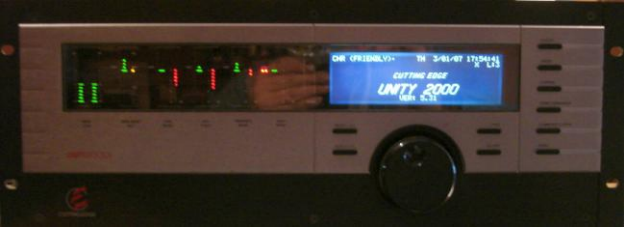A History of Audio Processing Part 6: In Their Own Words – Learning From the Pioneers
 by Jim Somich
by Jim Somich
with Barry Mishkind
[November 2019] Before his untimely death, Jim Somich and I had a number of conversations by phone and email as we discussed the history of broadcast audio processing and laid the basis for this article.
As in the previous installments, Jim took the lead on this guided tour. I get to help finish it off as a tribute to a great radio engineer.
It is very interesting to learn what it was that drove the different approaches to audio processsing.
As we saw in a previous part, for example, the Texar Audio Prisms were developed largely under pressure to counter a new processor at a competing station.
It seems to me that one of the best ways to understand the philosophy behind each processing line is to speak with the designers themselves. Although the keen competition amongst the manufacturers tends to keep the top guys from divulging any secrets, a chance to sit down and talk with them gives one a much greater appreciation for what goes into taking program audio and making it ready for the transmitter. I am sure you will be as fascinated as I was by what they had to day.
Contributors
In preparing this material, we were fortunate to be able to interview Bob Orban and Frank Foti, living legends in the processing world, and Cornelius Gould, a young turk who might well be the contemporary face of the processing designers on the cutting edge of the technology.
These three guys are among the best-placed to give us insights – not only into the current state of audio processing – but into what we can expect in the years ahead.
Given the packed schedules of most everyone today, you will understand that the following conversations were a combination of live, email and telephone conversations (including 2019 updates). If we listen carefully and are fortunate, we might learn something from these guys.
The Processing “Light” Goes On
Jim Somich: Frank Foti, while some people think you were an “overnight success,” I know you really exemplify being on a path of learning, experimenting, and finally, after a lot of hard work, succeeding in your goals. Who and what influenced you as you worked your way up to your first processor, the Vigilante?
 Frank Foti: During my stint at Z-100 in NYC (1983 to 1987) we had the Texar Audio Prisms. Up until that time, FM audio processors generally employed pre-emphasis before the (multiband) limiters.
Frank Foti: During my stint at Z-100 in NYC (1983 to 1987) we had the Texar Audio Prisms. Up until that time, FM audio processors generally employed pre-emphasis before the (multiband) limiters.
Upon grasping a full understanding about how that multi-band system worked, I kept thinking about a limiter system that managed pre-emphasis after the multibands, rather than before them.
My thinking was that the control loops in that architecture were essentially tilted upwards a bit, due to the emphasis, and that was causing uneven processing in the upper frequencies. Essentially the upper range of each audio band had a lower limiting threshold.
The question – and quest – became finding out what happens if the control loops are flat and the limiters are set to manage pre-emphasis via differing threshold levels.
Building on What Came Before
Jim Somich: Your first processor was actually an adaptation of an existing model was it not?
Frank Foti: Yes. The Vigilante grew out of the Aphex Dominator, Model 700. I had seen the prototype Dominator at NAB 1985, but it was a lot more elaborate than the finished product. The prototype appeared to be a direct answer to the Orban Optimod 8100, but with auto-adjusting crossover frequencies, and a few other new tricks. I never knew why that version never appeared.
However, upon playing with the original Dominator – which sounded very good if not pushed too hard – it became apparent that the timing was the same in all three bands. That caused the unit to become “busy” sounding quite rapidly, especially when set aggressively. Before ever having a schematic at hand, I found the R-C networks that governed the timing and began playing. It did not take long to “tune” the unit for a CHR station.
Eventually, a schematic was acquired. I began playing with the ALT (Automatic Limiting Threshold) circuit and more advancement in the Vigilante’s gestation occurred. Being able to modify the threshold settings in the Dominator empowered the box to manage pre-emphasis very consistently.

The “attack” and “release” functions were brought out to the front panel via three-position switches. The limiting thresholds were brought out via numeric “dial pots” that, in fact, were suggested to me by you! But the key sonic element – and improvement that we heard on-theair – was how much the high frequency domain opened up. This was the result of pre-emphasis insertion after the multi-bands.
Getting to the Cutting Edge
Jim Somich: Was the Vigilante a complete, all-in-one, stand-alone box or did it require support by other processors?
Frank Foti: At this early stage the unit only did the dynamic limiting. We used the clipper cards (8/9) from the Orban 8100, which worked quite well. Upon launching “Cutting Edge,” and building these [units] full-time, radio stations wanted an integrated solution; I designed our first distortion-controlled clipper, which was added to the Vigilante sometime in 1989.
Jim Somich: At this time, which processor designers influenced you most strongly? Frank Foti: The influence here was mainly Glen Clark. I thought his Audio Prism concept to be very good. I used to tell him that he needed to create a multi-band limiter version of the Prism. While the Dominator was multi-band, that was not the idea that was lurking in my head. Upon the modifications to the Dominator, it got closer, but those ideas eventually manifested themselves in the Unity – and eventually in the Omnia.
Creating Unity
Jim Somich: OK, that progression makes sense. Now what was the Unity, and how did it differ from the Vigilante?
Frank Foti: The Unity was our attempt at putting the rack of individual processor units in one box. The technology used was known as “digitally-sampled analog.” The idea was to clone a rack of gear that would have been a wideband AGC, multi-band compression, multi-band limiting, pre-emphasis, distortion controlled clipping, and the stereo generator. It worked quite well.

The clipper design came right from the Vigilante. The stereo generator included a composite clipper that performed clipping before the pilot was inserted. The entire system was governed by a microprocessor; it could save and recall a default, as well as user presets.
A concept we introduced with Unity, and carried forward to Omnia, was the idea to employ differing architecture into the dynamic sections. The Unity had feedback control on the lower two limiters and feed-forward on the upper two bands. This enabled the system to maintain the warm IMD-ish sound on lower frequencies, which feedback limiters tend to offer.
Jim Somich: That approach is a sort of doubleedge sword, right? IMD is not normally a desirable audio component.
Frank Foti: That is true. IMD is quite irritating on “presence” and “high” frequencies. On those bands, we utilized feed-forward control, which is inherently much lower in IMD. This type of processing offers a clean, open, and smooth high end, while retaining a rich fullness to the low end. We still use this method within Omnia processors.
Jim Somich: If you were asked to point out the main weakness of the Unity, what would that have been?
Frank Foti: In hindsight, the Unity never had the internal flexibility that a DSP box has. As such, there were many hindering factors that kept me from getting it to where the ideas that were still lingering up in the foggy grey matter needed to go.
Of course the Unity was successful enough in that it made the worldwide broadcast industry aware of our efforts. If anything, it got the company noticed when we introduced the Omnia, which was our first full DSP processor.
DSP and the Omnia
Jim Somich: Frank, how did your first DSP processor, the Omnia come about?
Frank Foti: Omnia was an outgrowth of the Unity, along with input from all those who were critical of the Unity. Moving into DSP illuminated many things for us; most notably was the whole notion about how to clip pre-emphasized audio without causing aliasing distortion. Steve Church and I put a solid two years into researching that one alone.

Omnia’s lineage follows my thinking all the way back to Z-100 and the rack of gear we had in NYC. The first goal – and what would have been the deal-breaker – was to create a hard-limiter (clipper) that didn’t generate that awful grunge effect that was obvious to the sound of other units and was giving DSP-based processing a bad name.
Within the dynamic sections, we were able to take advantage of the DSP processing power to add functions like “Make-Up Gain.” This allows the compressors to operate with slower overall timing, but “knows” when softer segments are occurring and will speed up the system only during those intervals.
Additionally, Omnia offers gating that is very intelligent. It can reset the dynamic gain to a preset platform level or just freeze gain during periods of gating. Stereo-EFX was designed to enhance stereo without destroying the natural sound field or exaggerate multipath due to increased RMS levels of the L-R signal.
The composite clipper that is incorporated into Omnia also contains a DSP version of “The Dividend” which keeps composite clipping products in the SCA region down to a minimum. This was a first for an integrated audio processor.
Jim Somich: Once you had a working prototype, how did you introduce it?
Frank Foti: I personally took the beta version of Omnia.fm to those customers who were not fans of the Unity. I figured if we could please the critics, then we were on to something. With all honesty, I can say that we visited close to 25 customers (the world over) – and every one of them purchased the Omnia!
Jim Somich: That is quite an achievement for any product! So, looking ahead – can I get any predicttions from you? What can we expect out of you and your team in the future?
Frank Foti: Looking into the future is always fun. We now live in a coded-audio world. Thus, audio processing is becoming more focused on that transmission method. Still, I feel there’s still at least one more, if not two, conventional broadcast processors yet to be designed for FM and AM (at least from our company). I’m not sure that those will be focused on more loudness. As we all know, processing creates LOUD audio today, all the way from the CD source straight through to the eardrum.
We will employ algorithms that will diagnose the signal and modify the architecture in order to reduce sonic artifacts. (We’re doing this already in the codec world with our SENSUS Technology.) Reduction of distortion, THD, and IMD, while maintaining competitive audio is the goal. Then again, hasn’t that always been the goal?
We’re moving towards a transition period from where we have dedicated boxes into the early stages of doing all processing as a PC application. We have already developed a processing farm where many instances of an audio processsing application are operating within one “engine” – a single box that allows up to a preset number of audio processors to run independently of one another. I/O is Ethernet to the station’s infrastructure or can be routed to dedicated nodes that are AES or analog.
Utility functions regarding processing are becoming more elaborate; the ability to display detailed information about a signal, or segment 5 thereof, is now available. Processing power, which once was a premium in cost, is now quite affordable in the digital domain, just as the lower-cost, high-performance opamps and VCA’s became during the analog years.
Jim Somich: Thank you, Frank. Speaking with you is always an education.
Fast Forward to 2019
It is interesting to note that most of the above chat with Frank Foti took place just before Jim Somich’s untimely death in February 2007.
Not surprisingly, just a year later, at the NAB Spring Show, some of the very concepts that Frank was discussing were unveiled in the new Omnia 11 audio processor.
So, let us now jump a decade later. Perhaps you have noticed that each time we thought we had reached the peak of audio processing advances, someone stepped in with another great idea.
With that in mind, we asked Frank, now where does processing go from here? In other words, what, is anything, is missing from the digital audio processors? Yes, he has something to say!
Frank Foti: “As we move forward with signal processing developments, the goal has always been to find methods/algorithms which yield improved audio quality and clarity for a given amount of processing. When accomplished, this is what yields the ‘cleaner and louder’ perception of the audio signal.
The Future of the Limiter/Clipper
Probably the most challenging function, in processing, to accomplish this is in the final limiter, or clipper section.
Since this is the operation where precision peak control must be performed, it is also the area where the most annoyance, in the form of distortion can be created.
The term distortion used here can be broken down into two distinct areas: harmonic and intermodulation distortion. The following is a brief description of each.
Unwanted Distortion
Clipper induced harmonic distortion (THD) is the most common annoyance heard when the signal has been overly truncated.
The “chopped off” portion of the signal becomes nasty harmonic components of the fundamental – especially the odd order harmonics – and that creates the scratchy, buzzy, raspy, crunchy, and broken perception of the signal. Basically, it has been ‘broken’ and that’s what results.
Intermodulation (IMD) generated distortion is what occurs when the action of the clipping method, or certain mechanisms employed to reduce harmonic distortion, create an effect where segments of the audio spectrum become affected by content from other parts of the spectrum.
This happens due to one frequency ‘intermodulating’ another frequency. This is usually most noticeable with lower (bass) frequencies, where the wavelength of the lower spectrum, will in essence push the midrange and high frequency spectrum into the clipper process, during the wavelength period of the bass frequency. There are various examples of content, where distortion of midrange audio can be heard, and it is occurring due to an underlying bass signal, which is pushing the midrange momentarily into the clipper.
Reducing the bass spectrum removes the midrange distortion, but it also removes the bass content as well.
Another IMD Problem
Another aspect of clipper system IMD annoyance occurs when various methods employed to reduce THD, generate IMD. This is especially annoying to transient signals such as percussive, or sharp signal changes.
There are two perceptions, which occur, from this action. There can be a perceived “smearing” to the signal, and an added “thickness” which does not sound musical/natural. It is almost as if the listeners ears were being pressed together in an unhealthy manner.
This is created due to added spectra resulting from whatever mechanism is employed to reduce THD. While there is reduction of the THD annoyance, it replaces that with another annoyance, which is increased IMD.
Less THD, More IMD
By example, the clarity of cymbals, or the snap of a sharp snare drum hit are totally lost.
Background segments get covered up, or lost, due to the added IMD content, which results in the perceived ‘thickness’ of the signal. A real world example: Probably the biggest weakness of the Optimod. When driving that clipper system deeper, the audio would get louder, but at the aural cost, where detail, clarity, and quality was lost.
Current Improvements
Recent developments are yielding improvements where we can reduce both THD and IMD simultaneously, within the clipper section.
Using methods that function in the time and frequency domain, we can enable sonic performance which results in effortless clarity, and competitive loudness.
Additionally, our “1 louder” method of pilot embedding delivers a full dB of added loudness at no penalty to the audio – yet all of the FMStereo parameters remain intact. Both of these functions are possible only with Omnia processsors.
As we continue this walk through processing history, we plan next to share a talk with Bob Orban. Please stay tuned!!!
– – –
Are articles like this helpful to you? If so, you are invited to sign up for the one-time-a-week.BDR Newsletter.
It takes only 30 seconds by clicking here.
– – –

